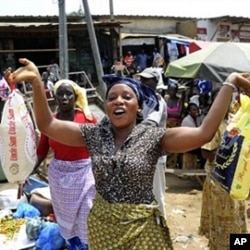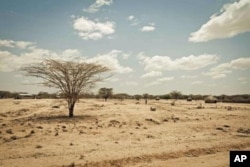This is Part 2 of a 5-part series: Climate Change
Continue to Parts: 1 / 2 / 3 / 4 / 5
One of the world’s eminent environmental scientists says modern agriculture has evolved over an 11,000 year period of “rather remarkable” climate stability.
“Agriculture as we know it today is designed to maximize production with that climate system,” said Lester Brown, a former farmer and founder of the Earth Policy Institute in Washington, DC.
Brown, a recipient of the United Nations Environment Prize, added, “But that climate system is no more. The earth’s climate system is now changing. And with each passing year, the climate system and the agricultural system are more and more out of sync with each other…making it more difficult for farmers to expand production fast enough to keep up with (world) demand (for food).”
The UN Food and Agriculture Organization (FAO) estimated that food production must be boosted by 70 percent by 2050 to meet growing demand.
But across the globe, and especially in Africa, there are “serious drops” in food output because of increases in the volume and intensity of heat waves, droughts and floods, explained Tanzanian agricultural economist Ephraim Nkonya.
Sir Gordon Conway, professor of international development at Imperial College in London, said more extreme weather events will happen in Africa because of climate change.
“You’ll get big droughts and big floods in many countries. Often a country will have both more droughts and more floods at the same time,” predicted the former chief scientist at Britain’s Department for International Development.
Environmental experts say the extreme weather events are exacerbated by global warming, principally caused by harmful gas emissions, such as carbon dioxide, from the burning of coal for energy.
It could ‘bring down civilization’
Brown has estimated that for every one degree C increase in temperature, yields of staple grains will drop by 10 percent. Large parts of Africa could warm by four degrees C by 2100, according to the Intergovernmental Panel on Climate Change.
Conway warned that famine in Africa could spike dramatically in the near future as a result of more droughts, desertification and dwindling water supplies. Resulting reductions in crop yields, he said, could be as much as 50 percent by 2020 and 90 percent by 2100.
“There are now more very dry spells in parts of Africa in the main cropping seasons, compounded by more days over 30 degrees C. The more days over 30 degrees, the greater will be the reduction in yields.”
Nkonya said, “Less food on world markets will mean that food will be more expensive and this scenario is already unfolding.” The economist analyzes the effects of climate change on agriculture and food production in Africa for the International Food Policy Research Institute (IFPRI).
Nkonya said higher food prices are leading to “more social instability” everywhere. “This we have seen from riots against more expensive food, including in African nations,” such as Algeria, Egypt, Nigeria and Senegal. He added, “These could soon become more widespread across Africa.”
Brown, whom the Washington Post has described as “one of the world’s most influential thinkers,” said the potential for food crises in poor countries is “the biggest threat to global stability” and one that could “bring down civilization.”
Face of African agriculture transformed
Nkonya said climate change would be particularly bad for African agriculture because the continent is almost completely reliant on rain, not controlled irrigation, to grow food.
He pointed out that Africa is also especially vulnerable to more intense droughts and floods as about 70 percent of its population “survives by farming” and a third of the region’s income is generated by agriculture.
“If agriculture collapses, Africa collapses,” said Nkonya. He said future dry conditions could lead to “considerable” decreases in outputs of two of Africa’s staple foods, maize and rice, as these crops need a lot of water to grow.
In some areas where maize now thrives, Nkonya predicted, its cultivation will be “impossible” because of sustained dry conditions. He suggested that higher temperatures could soon change the face of African food production, with a corresponding transformation of continental diets. Farmers, he said, will be forced to switch to crops that can grow in dry areas, such as cassava and millet.
Nkonya said hotter weather will boost numbers and varieties of pests and crop diseases. He added, “Because most African farmers don’t have the technical capacity to combat this, either with pesticides or with crops resistant to pests, food production will decrease.”
‘Governments will fall’
According to the FAO, just three crops – rice, maize and wheat – provide 60 percent of the world’s food. But Brown expects potentially disastrous decreases in their production because of climate change. “It’s already happening,” he said, citing recent examples from around the world.
“Last year, because of the intense heat and drought in western Russia, the Russian grain harvest dropped from roughly 100 million tons to 60 million tons,” Brown explained. “That severely reduced world grain stocks. It led to dramatic rises in grain prices and in food prices everywhere.”
Then, earlier this year, the world food supply suffered a further blow when severe heat and drought struck in the U.S., the world’s leading grain producer.
“So once again this year we’re going to see a reduction in world grain stocks, and grain prices are going to continue high and could go higher and food prices are the highest on record,” said Brown. “We may now be in a situation of chronic shortages and high and rising food prices.”
If this is so, the scientist said, it is “very bad news” for the world. “It’s going to create more and more political instability in the world and there’ll be more and more failing states,” he maintained.
Brown said it is “scary” but feasible to imagine a heat wave on the same scale as the Russian event striking the U.S., which grows more than 40 percent of the world’s grain, in the near future. If this happened, he said, the implications would be dire.
“That would have been an extraordinary shock to the world grain market. We would have seen grain prices climbing to levels we’ve never imagined before. In many of the lower income grain importing countries, they simply would not have been able to import enough grain for their people,” Brown explained.
If there are big crop failures in top food producers such as the U.S., China and Europe, he said it will lead to “violent food riots in country after country” and “governments will literally fall.”
Greatest threat to global food security
Brown also warned that the world “could pay the price” for not giving enough attention to the “very real” potential of a catastrophic food crisis in Asia as a direct result of climate change.
He said warmer temperatures in the region mean that glaciers, especially in the Himalayas and on the Tibetan Plateau, are melting and “shrinking significantly” and that some smaller glaciers have already disappeared.
Brown explained, “It is the ice melts from these glaciers that help sustain the major rivers of Asia during dry seasons and the irrigation systems dependent on those rivers. If the glaciers disappear, so will wheat and rice production in Asia.”
China and India are the world’s top producers of wheat and rice. “Therefore, the melting of these glaciers (in Asia) coupled with the depletion of aquifers present the most massive threat to food security the world has ever faced,” said Brown.
He added, “I don’t think that many people have a clue of just what a disaster the melting of glaciers on the Tibetan plateau alone would be. It could shrink the grain harvest in China and thus lead the Chinese into the world grain market to buy large quantities of grain, competing with consumers around the world for the global grain harvest, driving up world food prices.”
As a result, he suggested, people especially in developing countries would suffer, starve and die.
Sea level danger
Brown said the possibility of a significant rise in sea level because of warmer temperatures melting ice in polar regions represented another challenge to world food security, especially in Africa.
“Even a one meter rise in sea level would create immense problems in the world, including in Asia,” he stated. “It would inundate large parts of the rice-growing river deltas.”
According to a World Bank study, a one meter increase would cover a large part of the Mekong Delta, the heart of the rice industry in Vietnam, which is the second largest rice exporter worldwide.
While China and India produce the most rice, they use it to feed their domestic populations and export comparatively little.
Thailand has long been the largest rice exporter. But recent floods, worsened by the effects of climate change, say environmentalists, have destroyed its rice crops. This has sparked price increases all over the world, and has ensured that many poorer people can’t afford the more expensive rice.
For millions of Africans, rice is a staple food. Africa is the second largest regional importer of rice in the world. South Africa, Nigeria, Senegal and Ivory Coast are all among the world’s leading importers of rice.
New technologies
Top scientist Gordon Conway is convinced that new technologies, such as genetic modification of seeds to make them drought tolerant, must be the most important part of Africa’s strategy to combat climate change and its threat to the continent’s ability to grow food.
However, IFPRI’s Ephraim Nkonya said there’s little indication that the necessary investments are being made in new advances in agricultural research in Africa at the moment. “Adaptation to climate change, for example using crop varieties that are adapted to drought – the adoption rate (in Africa) is very low,” the agricultural economist pointed out.
Nkonya said the new technologies are currently too expensive for Africa.
Peter Holmgren, an agricultural scientist and director of a division of the FAO concerned with climate change, is more optimistic. He said the phenomenon is an opportunity for the world to improve its methods of producing food.
“I think there is a great potential to achieve better, more productive, smarter agriculture in many places,” he said. “We are on the path to investing in agriculture that looks at both improved productivity and income to farmers and at the same time offers more resilience to fluctuations in prices as well as to weather conditions.”
But Nkonya said this path is still a long way off, especially for Africa. He added, “The problem is that the effects of climate change, like droughts and floods, that harm food production are already here, and there is no sign of the funding or the political will that’s needed to boost agriculture in Africa.”












